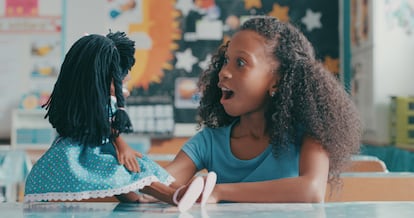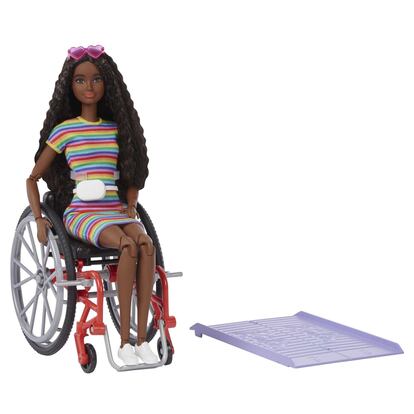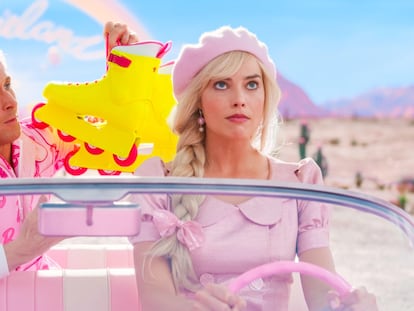How playing with a Black Barbie in a wheelchair can improve children’s self-esteem
A lack of representation in toys, stories and movies negatively impacts children’s sense of self-worth. How they perceive themselves is developed in comparison with people they consider to be similar or different from themselves

It is Clara’s fourth birthday, and she is about to open her presents. Her friends watch her attentively as she shows off her new treasure: “It’s a Black Barbie in a wheelchair!” The parents exchange glances and smile. Her friend Juan (also four years old) brings his Hulk doll closer, stretches his hands and says: “Come on, Barbie, I’ll take you to the park.” Neither the children nor the adults have ever seen a paralyzed doll before. In addition to their fascination with the wheelchair mechanism (and Barbie’s hair), the following scene unfolds at the entrance of the school the next day: a girl five years older enters the school in a wheelchair, and Clara and Juan look at each other in mutual comprehension; without saying a word, they fully understand what is going on. This is a real example that demonstrates the importance of children having diverse references in their daily lives and, as a result, being fully committed to diversity in education and in life.
Laura Marcilla is a psychologist and sexologist. She is part of the association Almería Con Orgullo (Almería with Pride), an LGBTQ association that also works for representation of the gay community in the broader culture. She says that all people need to see themselves reflected because they look for points of similarity with others; she adds that “the feeling of belonging, of perceiving that we are part of a community, is very important for building self-esteem.” While this applies to everyone, it is especially important for children, particularly those who belong to a minority or underrepresented group, Marcilla explains. Self-concept—that is, how children perceive themselves—is formed in comparison with people they consider to be the same, similar or different from themselves. “Therefore, if a child, for example, has no examples around her in pictures or stories, it can lead to feelings of isolation or inferiority,” says the psychologist. “If there are representations but they are stereotyped or exaggerated and always reproduce the same prejudices, the result won’t be positive either,” she says.
A total lack of representation for children can have a negative impact on feelings of worth. Rocío Quillahuaman was born in Peru and came to Barcelona as a child. She was gifted at school and did her homework while her mother cleaned apartments. Now, she is well known on social media for her funny cartoons; she has almost 200,000 followers on Instagram alone. A few months ago, she published Marrón [Brown], a book for teenagers in which she explains how different (brown) she felt when she was young. Quillahuaman says that seeing oneself reflected in the culture serves to validate a person, helps people feel hope and gives them the ability to aspire to something: “It would have helped me to accept my identity back then…Not seeing myself represented in any cultural product I consumed made me feel like I was worthless to society. Being rendered invisible makes you feel like you don’t exist for everyone else, that you are not part of [a place]. It’s another way of pushing us aside, of marginalizing us.”
Marcilla explains that in Europe the representation of white, normative bodies that do not have any kind of disability is predominant. “And often the exceptions, when there are any, are relegated to a secondary role or even associated with the story’s villain. For example, in the Little Mermaid, Ursula is fat and also the bad guy.” The movies for children and young people with which parents grew up didn’t always get it right: “The cats with Asian characteristics in Lady and the Tramp are evil. Aladdin gets whiter over the course of the movie, so you can associate whiteness with success,” she observes.
It’s true that Mattel and Disney have started to make progress in this regard: racially diverse and even single princesses already exist, but there still isn’t an overweight or lesbian character. Disney’s latest movie Strange World stars a biracial, openly gay teenager, but the plot has nothing to do with his skin color or sexuality; he could just as easily be white and have a girlfriend. On the other hand, Mattel has released a line of inclusive Barbies: there are now dolls that are curvy, short, hard of hearing (with hearing aids), as well as ones who have Down’s syndrome or vitiligo.

Writer and educator Desirée Bela-Lobedde has two daughters, ages 14 and 16. She also teaches anti-racism workshops, and says that, as a mother, it is necessary to provide children with a diversity of references. “If they are [children] with normative bodies, it helps them to see those other bodies; if they are [children] with non-normative bodies, it helps them to recognize themselves in those references and see a positive representation of bodies like their own,” she says. She adds that “if minors are being taught that their body is not appropriate, preventing them from seeing bodies like theirs reinforces the feeling that there is indeed something wrong with their body and therefore it should not be shown.” That, in turn, promotes body shaming.
Contrary to popular belief, imagination does have certain limits. It is easier to imagine what we know or are familiar with. “Just as we cannot imagine a new color that we have never seen, it’s much more difficult to imagine realities that we have never observed,” says Marcilla. For that reason, the psychologist recommends children’s stories that open up new worlds and normalize others’ existence.
Sign up for our weekly newsletter to get more English-language news coverage from EL PAÍS USA Edition
Tu suscripción se está usando en otro dispositivo
¿Quieres añadir otro usuario a tu suscripción?
Si continúas leyendo en este dispositivo, no se podrá leer en el otro.
FlechaTu suscripción se está usando en otro dispositivo y solo puedes acceder a EL PAÍS desde un dispositivo a la vez.
Si quieres compartir tu cuenta, cambia tu suscripción a la modalidad Premium, así podrás añadir otro usuario. Cada uno accederá con su propia cuenta de email, lo que os permitirá personalizar vuestra experiencia en EL PAÍS.
¿Tienes una suscripción de empresa? Accede aquí para contratar más cuentas.
En el caso de no saber quién está usando tu cuenta, te recomendamos cambiar tu contraseña aquí.
Si decides continuar compartiendo tu cuenta, este mensaje se mostrará en tu dispositivo y en el de la otra persona que está usando tu cuenta de forma indefinida, afectando a tu experiencia de lectura. Puedes consultar aquí los términos y condiciones de la suscripción digital.
More information
Archived In
Últimas noticias
Most viewed
- Reinhard Genzel, Nobel laureate in physics: ‘One-minute videos will never give you the truth’
- Oona Chaplin: ‘I told James Cameron that I was living in a treehouse and starting a permaculture project with a friend’
- Pablo Escobar’s hippos: A serious environmental problem, 40 years on
- Why we lost the habit of sleeping in two segments and how that changed our sense of time
- Chevy Chase, the beloved comedian who was a monster off camera: ‘Not everyone hated him, just the people who’ve worked with him’










































